THE UNITED REPUBLIC OF TANZANIA NATIONAL EXAMINATIONS COUNCIL OF TANZANIA ADVANCED CERTIFICATE OF SECONDARY EDUCATION EXAMINATIONS
131/1 PHYSICS 1
(For Both School and Private Candidates)
Time 3 Hours Year: 2012
Instructions
1. This paper consists of sections A and B with a total of ten (10) questions.
2. Answer all questions in section A and two (2) questions from section B.
3. Section A carries seventy (70) marks and Section B carries thirty (30) marks.
4. Marks for each question or part thereof are indicated.
5. Mathematical tables and non-programmable calculators may be used.
6. Cellular phones and any unauthorized materials are not allowed in the examination room.
7. Write your Examination Number on every page of your answer booklet(s).
8. The following information may be useful:
Acceleration due to gravity, g = 9.8m/s 2 .
Stefan's constant, = 5.67 x 10-8 Wrn -2K 4 ![]()
Radius of the sun, Rs 7.04 x 108 m . Speed of light, c 3.0 x 108 m/s .
Wien's constant, 2.9 x 10-3 mK .
The value of the ratio 9.0 x 109 mF
Permeability of free space, go = 4m x 10 7 NAO
Electronic charge, e = 1.6 x 10 9 c.
Mass of electron, Me = 9.1 x 10-31 Kg
Velocity of sound in air, v = 340m/s. Plank's constant, h = 6.63 x 10 34Js .
Avogadro's number, NA = 6.02 x 1026 atoms/Kmol.
Radius of the earth, Re = 6.4 x 103 km .
Coefficient of thermal conductivity of Aluminium = 210Wm-1 K-1![]()
Distance of the Earth from the sun, R = 1.5 x 1011m Pie, IT = 3.14
1.(a)(i) Briefly explain two types of errors that are likely to occur whenever an experimental measurement is made.
(ii) The length, L of a simple pendulum which is about 0.5m can be measured within Imm. What accuracy is required in the measurement of the periodic time, T of 100 oscillations if the errors in L and T are to produce equal percentage in the calculated value of acceleration due to gravity, g?
View Ans(b) (i)How is a precise physics experiment related to an accurate one?
(ii) The diameter of a steel rod is given as: (56.47±0.02)mm. What does this mean?
View Ans(c ) (i) What is meant by the statement that "an equation is homogeneous with respect to its units"?
(ii) The stress S, required to fracture a solid can be expressed as s = k where, k is a d dimensionless constant, E is the Young's modulus and d is the distance between the planes of atoms separated by the fracture. If the equation is dimensionally consistent, find the dimensions of the physical quantity, X and suggest the meaning of this quantity.
View Ans
2. (a) Distinguish the terms projectile and trajectory as applied to projectile motion.
View Ans(b) A meteorite is traced by radar as it falls through the earth's atmosphere when its altitude is 3.0 x 10 4 m . The screen shows that the meteorite is travelling with a velocity of 58.3m/s at an angle of 28.3 0 below the horizontal. In the absence of air and at re-entrance to the earth's atmosphere;
(i) How much time elapses before the meteorite strikes the earth?
(ii) What is the magnitude and direction of the velocity of the meteorite just before the impact with the earth?
View Ans(c) (i) What assumptions are made in the treatment of projectile motion?
(ii) Find the angle of projection of a projectile at which the horizontal range and the maximum height have equal values.
View Ans3. (a)(i) A sailboat cannot be propelled by air blown on its sails from a fan attached to the boat. This is because as the air leaves the fan it exerts a reaction on the fan (and the boat) equal to the force that the air from the fan will exert on the sails. Since action and reaction are equal and opposite, the two forces will cancel each other.
(ii) Action and reaction cannot produce a net force on an object because they are equal and act in opposite directions.
View Ans(b) (i)
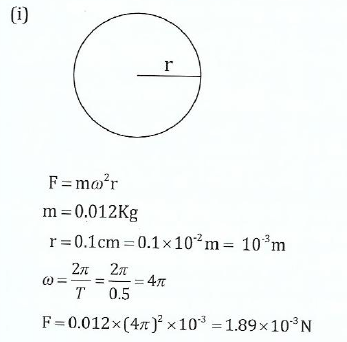
(ii) The force performs no work in a circular orbit because it does not act in the direction of motion but rather perpendicular to the motion of the ball.
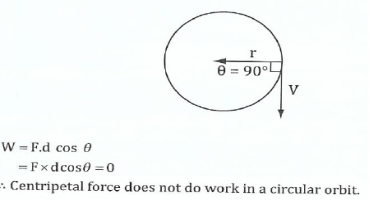
(c)
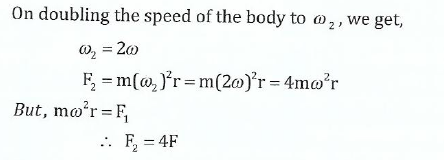
Thus, on doubling the speed of the body, the force on it quadruples (increases 4 times).
View Ans(c) If the speed of the ball in (b) is doubled, by what factor does the centripetal force increase?
View Ans(b) (i) Mention two factors which may change the value of surface tension.
(ii) Give comments on the statement that "water droplets are slippery when they fall on an oily surface".
View Ans(c) A particle rests on a horizontal platform which is moving vertically in a simple harmonic motion with amplitude of 50mm. If above a certain frequency the particle ceases to remain in contact with the platform throughout the motion:
(i) Determine the lowest frequency at which this situation will occur.
(ii) At what position will the particle cease to remain in contact with the platform?
View Ans5. (i) What is the difference between Kelvin temperature scale and Celsius temperature scale?
(ii) Mention three basic advantages of a gas thermometer.
View Ans(b)(i) What is meant by a "perfect thermal source" as used in thermal radiation?
(ii) The coefficient of volume expansion of glycerine is 3.0 x 10 4 m . What is the fractional change in its density for a 30 0 C rise in temperature?
View Ans(c) (i) Define thermal conduction.
(ii) An aluminium saucepan in contact with a hot plate has a base of diameter 20.0cm and a thickness of 0. 5cm If the saucepan contains water boiling away at the rate of 0.15gs -1, estimate the temperature at the lower surface of the saucepan vessel.
View Ans
6. (a) (i) What is a perfectly Black body?
(ii) Give one limitation of Newton's law of cooling.
View Ans(b) Briefly explain the following:
(i) Why does a good absorber of radiant energy appear black?
(ii) Why do two sheets of similar glass insulate much more effectively when separated by a thin layer of air than when they are in contact?
View Ans(c) A roof which measures 20m x 50m is blackened. If the temperature of the sun's surface is 6000k, calculate the solar energy incident on the roof per minute, assuming that half of it is lost when passing through the earth's atmosphere.
View Ans7. (a) Define beat frequency.
View Ans(b) (i) List down four necessary conditions for a stationary wave to be formed.
(ii) An open pipe of length 15cm and a pipe of length 11.5cm closed at one end are both surrounding their first overtones. If their notes are of the same frequency, what will be the end correction of the two pipes? State assumption made in arriving at your answer.
View Ans(c) A transverse sinusoidal wave is generated at one end of a long horizontal string of lineal density of 1.8 x 10-3 kg/m and is kept under tension of 12.0N by a bar which moves up and down repeating regularly twice each second through a distance of 0.25m. Determine the: (i) Amplitude.
(ii) Wavelength of the wave.
View Ans8. (a) Define the following terms:
(i) Curie temperature.
(ii) Remanance.
(iii) Coercive force.
View Ans(b) (i) What is meant by electrical oscillation as used in electrical circuit?
(ii) Briefly explain how a permanent magnet and a current in a conductor can be used to demonstrate electromagnetic induction.
View Ans(c) A toroid of mean circumference of 0.5m has 500 number of turns, each bearing a current of 0.15A If the core is filled with iron of reflective permeability of 5000, calculate the:
(i) Magnetic field intensity.
(ii) Magnetic flux density.
View Ans9. (a) (i) Define the term drift velocity.
(ii) A copper wire of cross-sectional area of 3.0mm2 carries a current of 5.0A. Find the magnitude of the drift velocity of electrons in the wire.
View Ans(b) (i) The resistance of an electric conductor varies linearly with its temperature. Write down the equation for this variation.
(ii) State the significance of the slope per unit resistance for the variation in (b) (i) above.
View Ans(c) A cell of e.m.f, E and internal resistance, r is used to drive a current, I through a load of resistance, R. Show that for maximum electric power to be transferred to the load, a load resistance, R must be equal to the internal resistance, r of a cell.
View Ans10. (a) (i) Distinguish between "frequency modulated" and "amplitude modulated" radio waves.
(ii) Explain why FM radio broadcasting is currently more preferred than AM radio broadcasting.
View Ans(b) The speech signals in the frequency range of 300HZ to 3400HZ are used to amplitude modulate a carrier wave of frequency 200KHz. Determine the:
(i) Band width of the resultant modulated signals. (ii) Frequency range of the lower side band.
View Ans(c) The switching and amplifying action of a transistor was done by the circuit diagram below (Fig. 1).
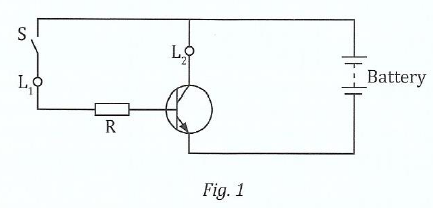
Briefly explain how the circuit above can act as:
(i) a switch (ii) an amplifier
View Ans11. (a) (i) Define electric potential at a point.
(ii) Two capacitors of capacitance 1 x 10 6 F and 1 x 10"8F are charged to the same potential. Give comments on which capacitor will give more intense electric shock if touched.
View Ans(b) (i) What is meant by relative permittivity?
(ii) The spherical shell of Van de Graff generator is to be charged to a potential of 106V.
Calculate the minimum radius of the shell if the dielectric strength of air is 3 x 106 Vm-1
View Ans(c) (i) Sketch a graph to show how a charge, Q varies with time, t during discharging process of a capacitor.
(ii) What is the significance of the gradient at any point along your graph in (c) (i) above?
View Ans12. (a) (i) Compare the electrostatic and gravitational forces that exist between an electron and a proton.
(ii) The distance, r between an electron and proton in hydrogen atom is about 5.3 x 10-11 m Compute the electrical and gravitational forces between these two particles.
View Ans(b) A capacitor Cl is charged to a potential difference, VI. The charging battery is removed and the capacitor is then connected to uncharged capacitor C 2 as shown in Fig. 2.
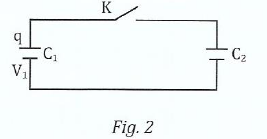
(i) What is the final potential difference, V across the combination?![]()
(ii) Find the stored energy before and after the switch is thrown.
(iii) Is there any difference between the energy before and after the switch is thrown? Give reasons for your answer.
View Ans13. (a) (i) Define ionization potential.
(ii) Briefly explain the fact that de-Broglie waves are referred to as matter waves though they are not composed of matter.
View Ans(b) The three lowest energy levels of the electron in the hydrogen atom have energies of El =-21.8 x 10 19 J, —-5.43 x 10 19 J and E3 =-2.43 x 10-19 J. Determine:
(i) The wavelength of Ha-spectral line due to the transition between energy level, E3
![]() and E
and E
(ii) The potential difference that enables an electron to be accelerated and cause the emission of H -spectral line.
View Ans(c) State any assumption made to support your answer in (b) (i) and (ii) above.
View Ans14. (a) (i) Name three layers of the atmosphere.
(ii) Describe any two major zones of the earth.
View Ans(b) (i) What are the factors that influence the velocities of P and S waves?
(ii) The P and S waves from an earthquake with a focus near the earth's surface travel through the earth at a nearly constant speed of 8km-1 and 6km-1 respectively. If there is no reflection and refraction of waves, how long is the delay between the arrivals of successive waves at a seismic monitoring station at 90 0 in the latitude from the epicenter of the earthquake?
View Ans15.(a) (i) What do you understand by the word environment physics?
(ii) Briefly explain three effects of seismic waves.
View Ans(b) (i) Mention three types of environmental pollution.
(ii) Explain on the following climatic factors which influence plant growth:
- Temperature;
- Relative humidity; and
- Wind.
View Ans
ANSWER

Hub App
 For Call,Sms&WhatsApp: 255769929722 / 255754805256
For Call,Sms&WhatsApp: 255769929722 / 255754805256
 For Call,Sms&WhatsApp: 255769929722 / 255754805256
For Call,Sms&WhatsApp: 255769929722 / 255754805256
WHATSAPP US NOW FOR ANY QUERY
App Ya Learning Hub Tanzania





